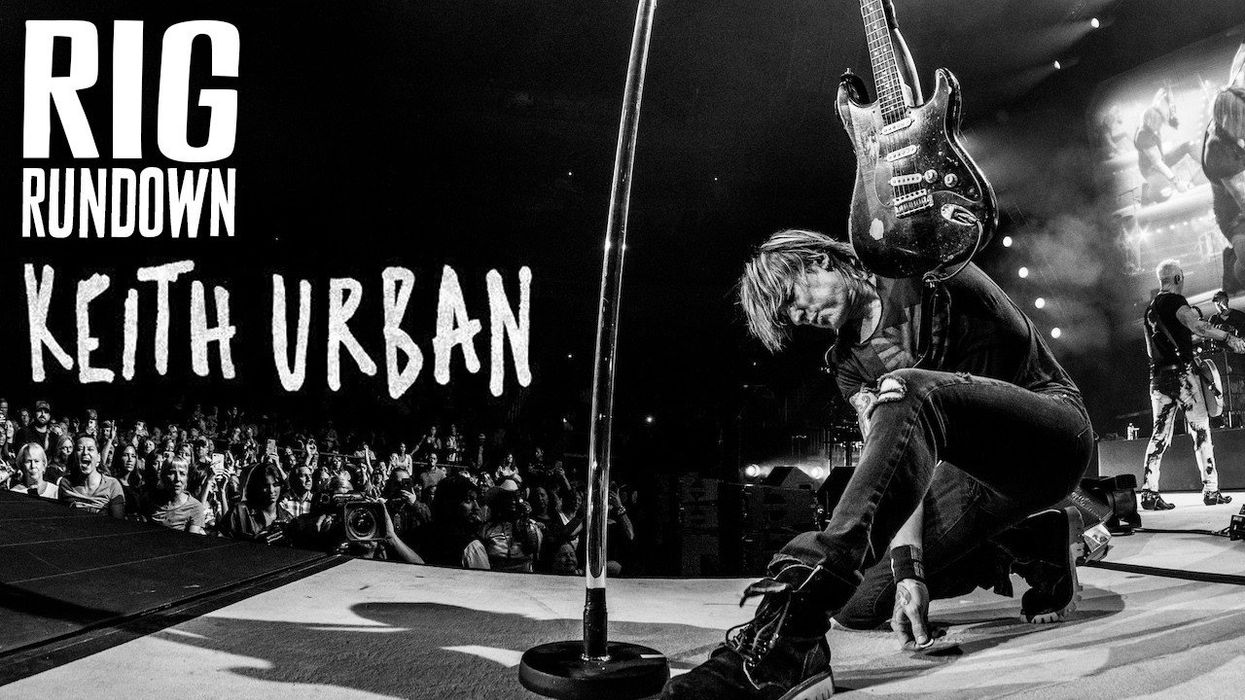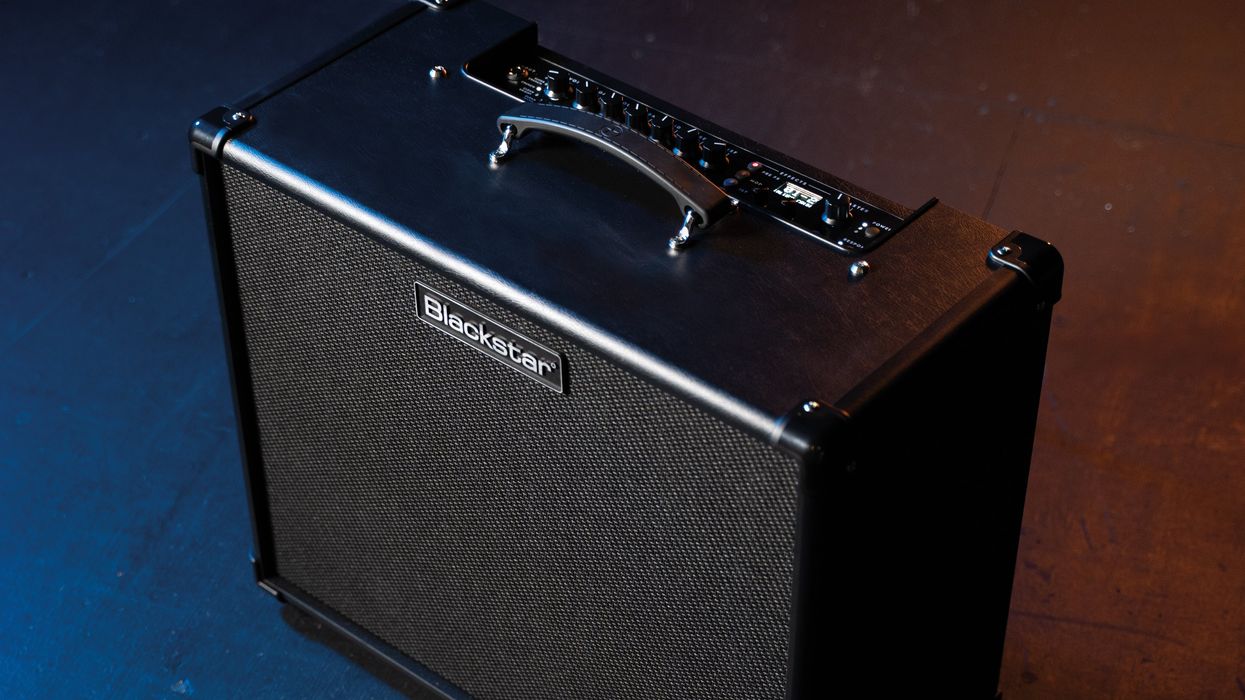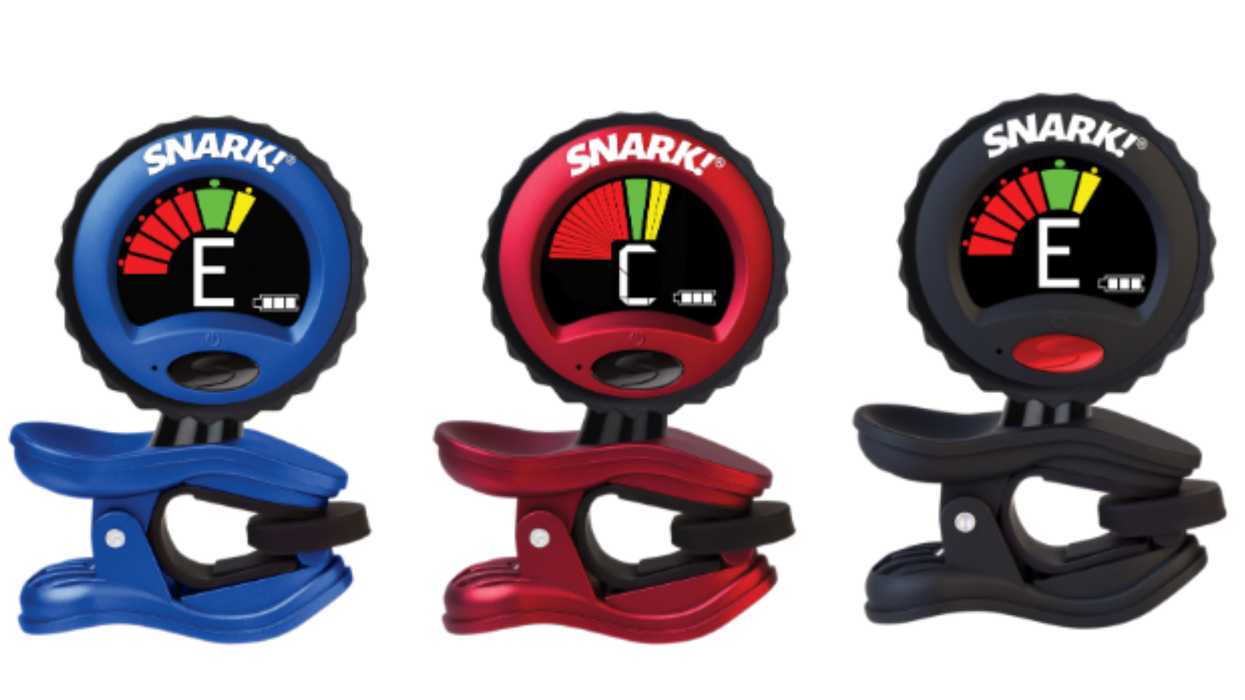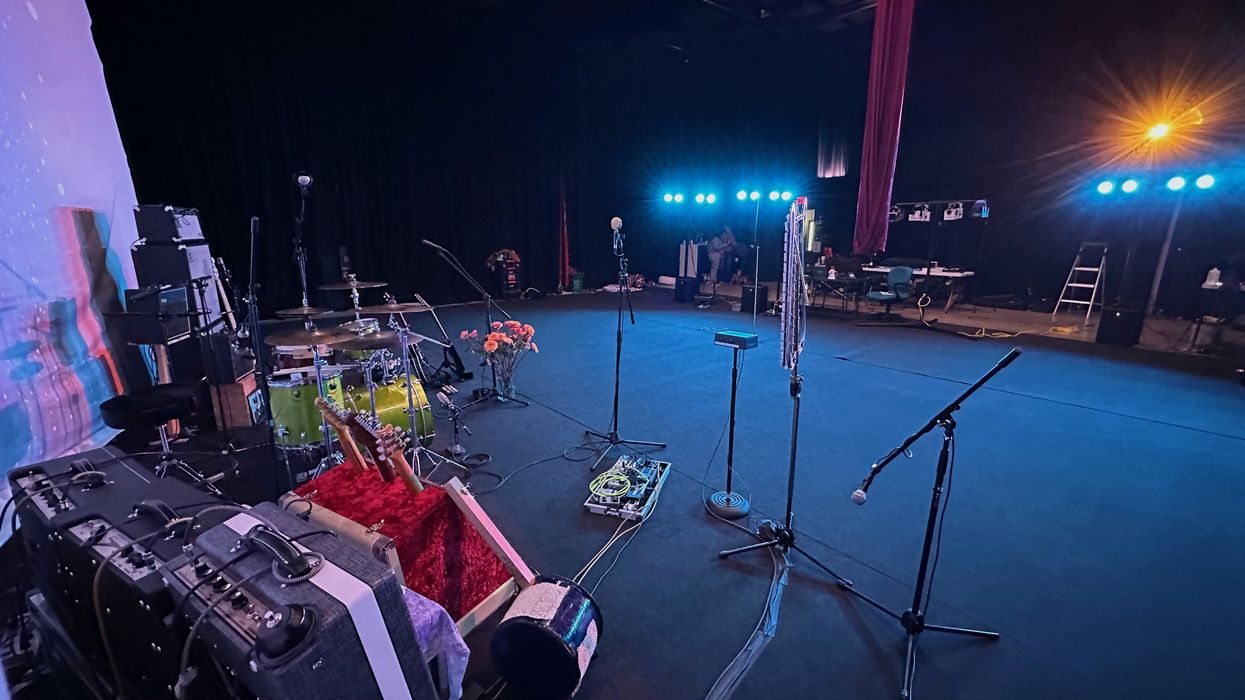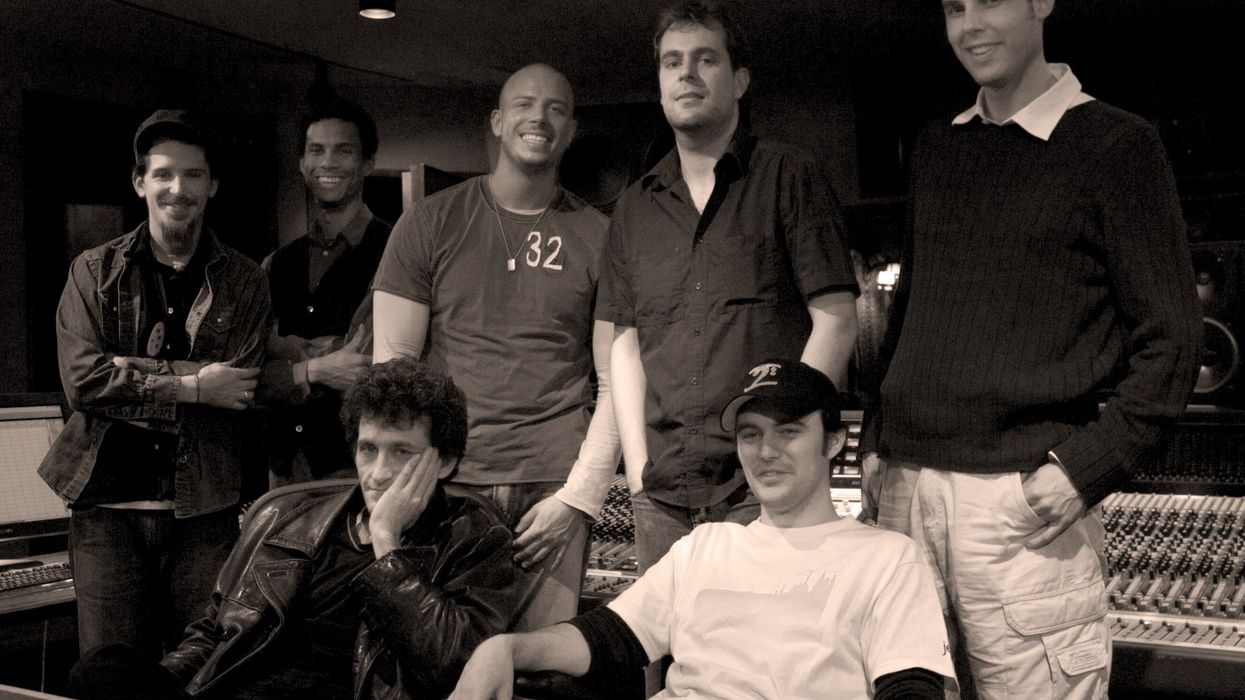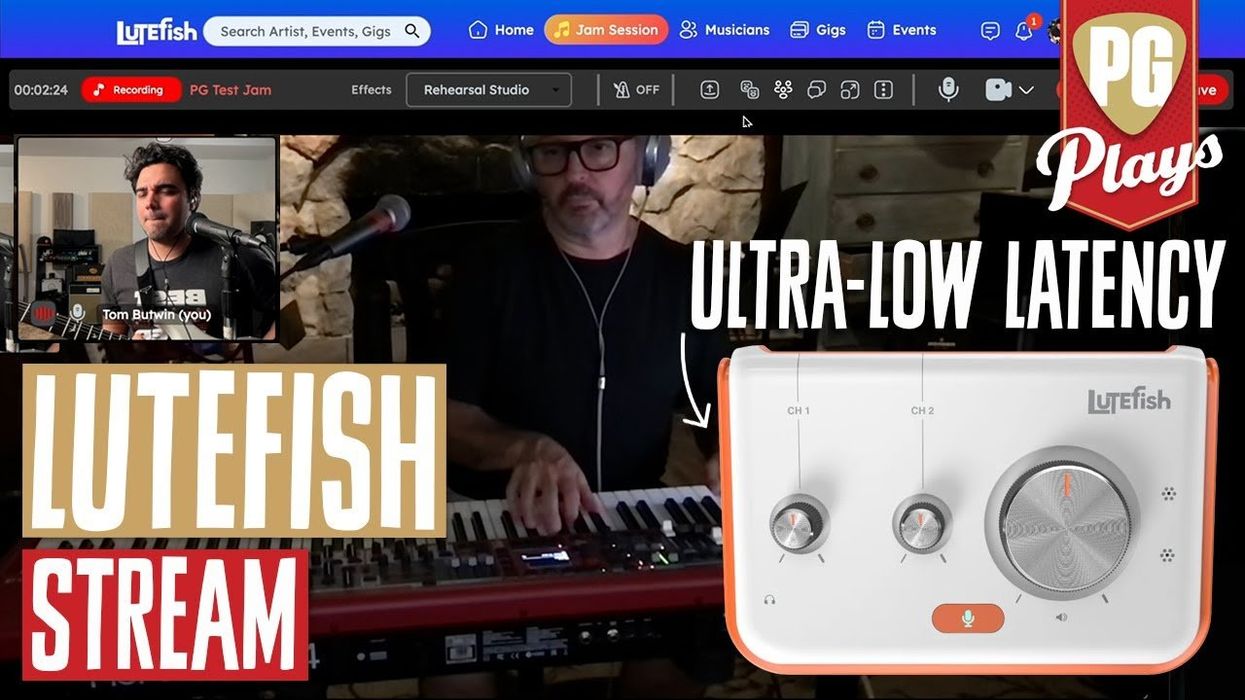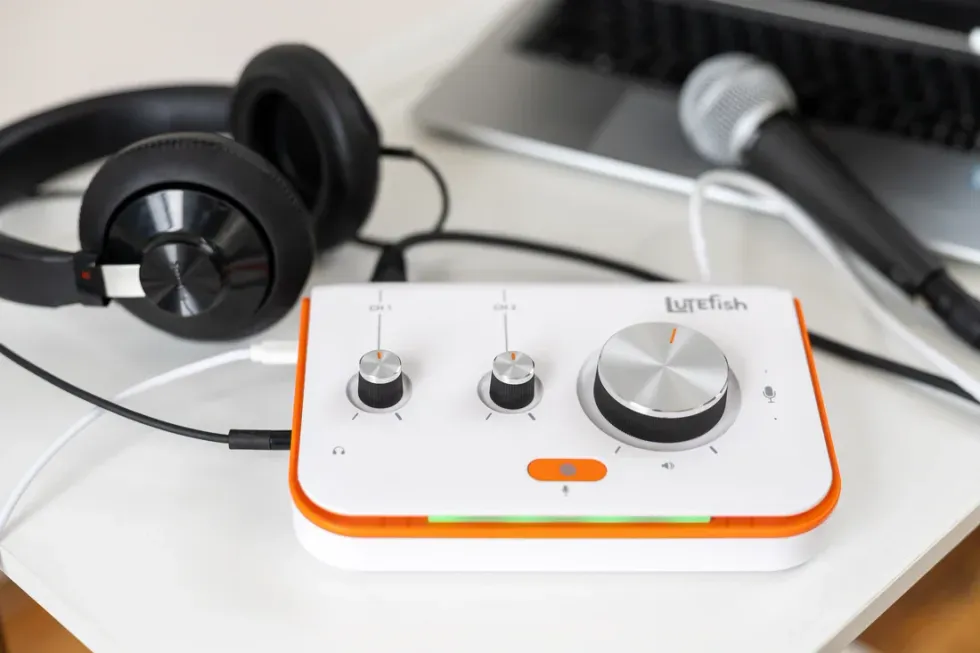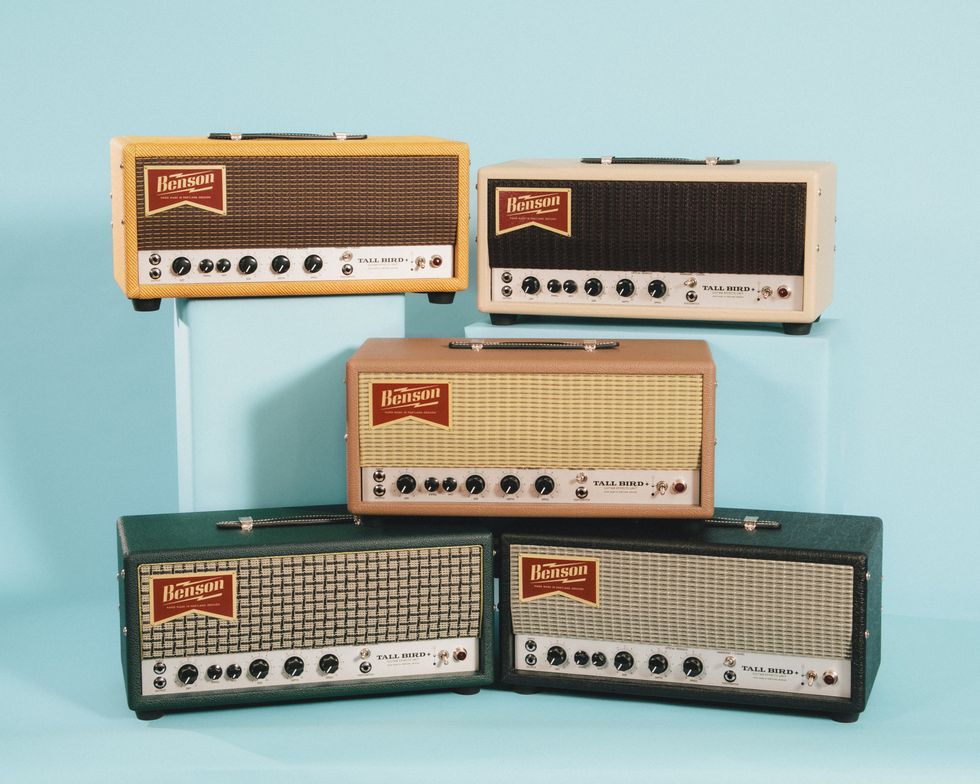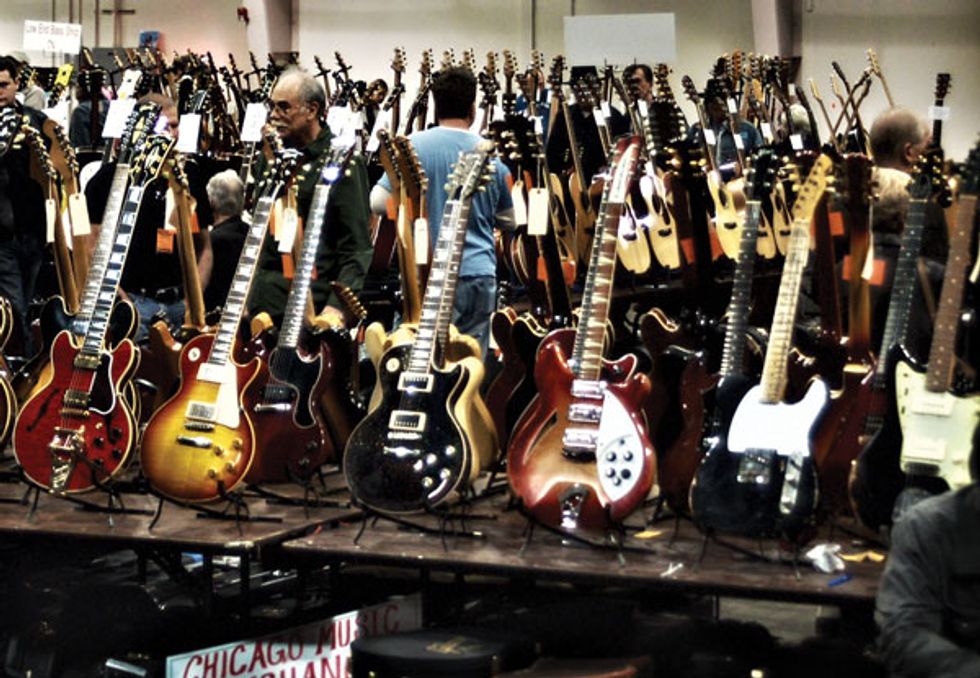 A forest of guitars on the floor of the Chicago Guitar Show. |
There was a steady, robust stream of players coming through the doors of the 23,000 square foot DuPage Expo Center, even on one of the first truly beautiful weekend afternoons of the summer season. The tabletops stretched from corner to corner without leaving any significant holes in the floor plan, and all were well stocked with beautiful pieces. Abbreviated guitar and amp demos bounced off the walls and floated around the room—thanks to flyers littered around the hall requesting that players limit their testing to one minute, for the sake of the acoustic dealers in attendance. Dealers eyed the front entrance for walk-ins. You might not call it a smash success, but for all intents and purposes, everyone seemed to be enjoying themselves. I asked the two amigos about their impressions of the show thus far.
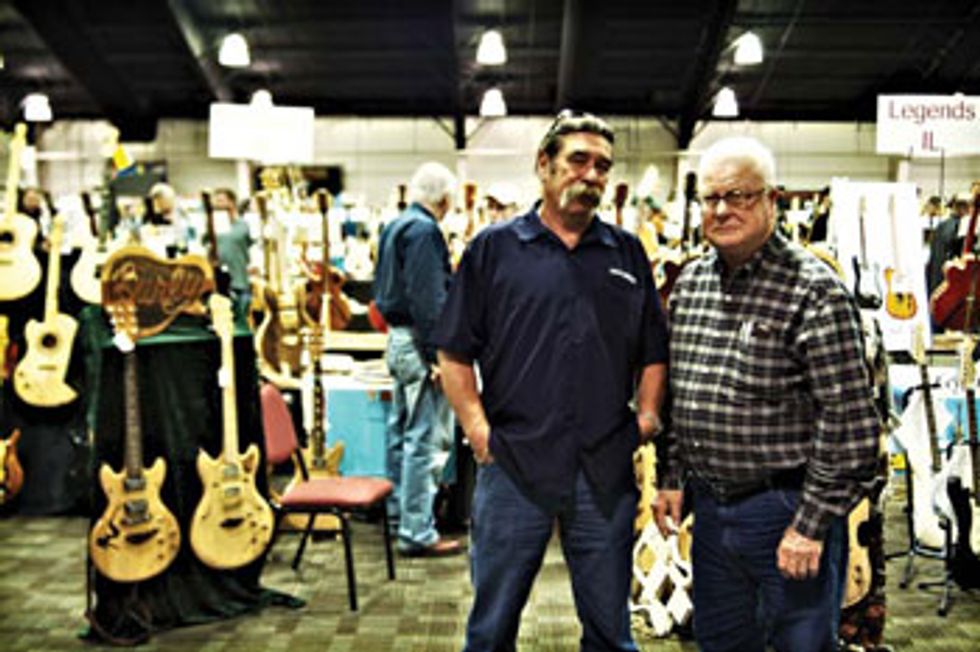 Dave Crocker (left) and John Brinkman (right). |
Although it may seem a bit odd for a longtime show organizer and savvy vintage player to be pleased with flat traffic numbers, it’s a sharp reflection of the odd place the vintage market has found itself in. Recently one of the hottest investment opportunities available to people with nostalgic memories and cash to burn, the vintage market is now down 20 to 30 percent from its 2007 peak, with oversaturated pockets of the market down even further. It has been battered by the same economic forces that have plagued every other collectible market in the US, from muscle cars to guns. An accelerating foreclosure rate, pervasive consumer uncertainty and a drastic contraction of the credit markets brought the emphasis from high-end investments and “pleasure” purchases back to the essentials.
But, interestingly enough, even as the general economic news continues to look unimpressive at best, most of the dealers gathered for the third show of the 4 Amigos 2009 calendar seemed to be optimistic, albeit cautiously so. Perhaps it’s because any investment market is, at its core, a confidence game. If you can first sell yourself on a turnaround, you can sell others on it, too. Or perhaps it’s because it is difficult to extinguish people’s deeply-held excitement in a “passion” market like the guitar. Whatever the reason, it seemed that even the most buffeted dealers were looking forward to the coming months with high hopes instead of high anxiety.
“After Dallas [in April], even the other dealers I talked to there said they had seen an increasein sales before Dallas, and it’s been brisk ever since. I think we’ve turned a corner,” says Jim Singleton, owner of Jim’s Guitars, as we sat in his compact, U-shaped booth. “Things are starting to pick up.”
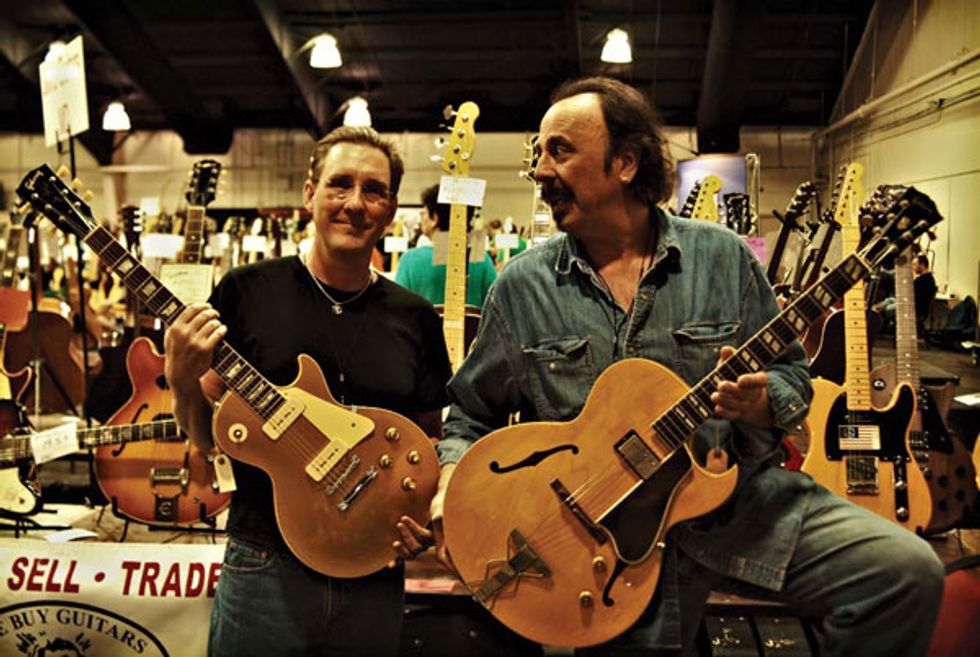 Jim Singleton (left) and George Tsantis (right). |
But before we explore that optimism, we should take a quick, cursory step back, if only to truly appreciate how the vintage market got to its current point. Although vintage guitars have been generally considered a good investment vehicle since the mid-1980s, when baby boomers re-entered the market after some time away, the last eight years of the market turned into a frenzy. With the advent of truly easy money in real estate, stock markets that seemed impervious to gravity, and low-interest home equity lines of credit that never seemed to dry up, the vintage guitar market represented a prime opportunity to increase returns and diversify portfolios with similarly little risk. A market long dominated by players and aficionados of great craftsmanship, the vintage world quickly went mainstream.
“The people buying guitars were no longer musicians. They were doctors and lawyers and brokers. The guitars got too expensive for real players to buy,” recalls Kevin Borden, resident PG vintage expert and long-time dealer. “It got insane. There were certain areas of the market that were, quite frankly, 100 percent overvalued.”
The passion part of this passion market was replaced with excessive speculation, done on behalf of more and more outside investors. Musicians had long evacuated for safer, more reasonable territory. Prices lost their footing in logic, and were increasing almost daily. George Gruhn wrote in a 2005 newsletter: “While many dealers and collectors seem to be of the opinion that prices can only go up, it is my opinion that feeding frenzies do not necessarily result in either the best decisions or long term stability.” And even though trusted sages like Gruhn were sounding the warning bells, they were unable to sway a market captivated by $50,000 Strats, $200,000 Les Pauls and no end in sight. It was a party, and the party was good.
Of course, all good speculative bubbles have to come to an end, but the vintage market crash, along with almost every other collectible market, received a great deal of help from a faltering US economy. As the housing market began its painful cratering in mid-2007 and accelerated into the fall, the vintage market quickly followed. It was a logical, expected reaction, according to Jim Singleton.
“A large segment of [vintage] buyers held real estate,” Singleton explained, “so when the real estate market was strong, the money was there and they were investing in guitars and antique cars and baby boomer stuff. When that money dried up, it affected this market and every other market. Just about every nonessential luxury market has gone down.”
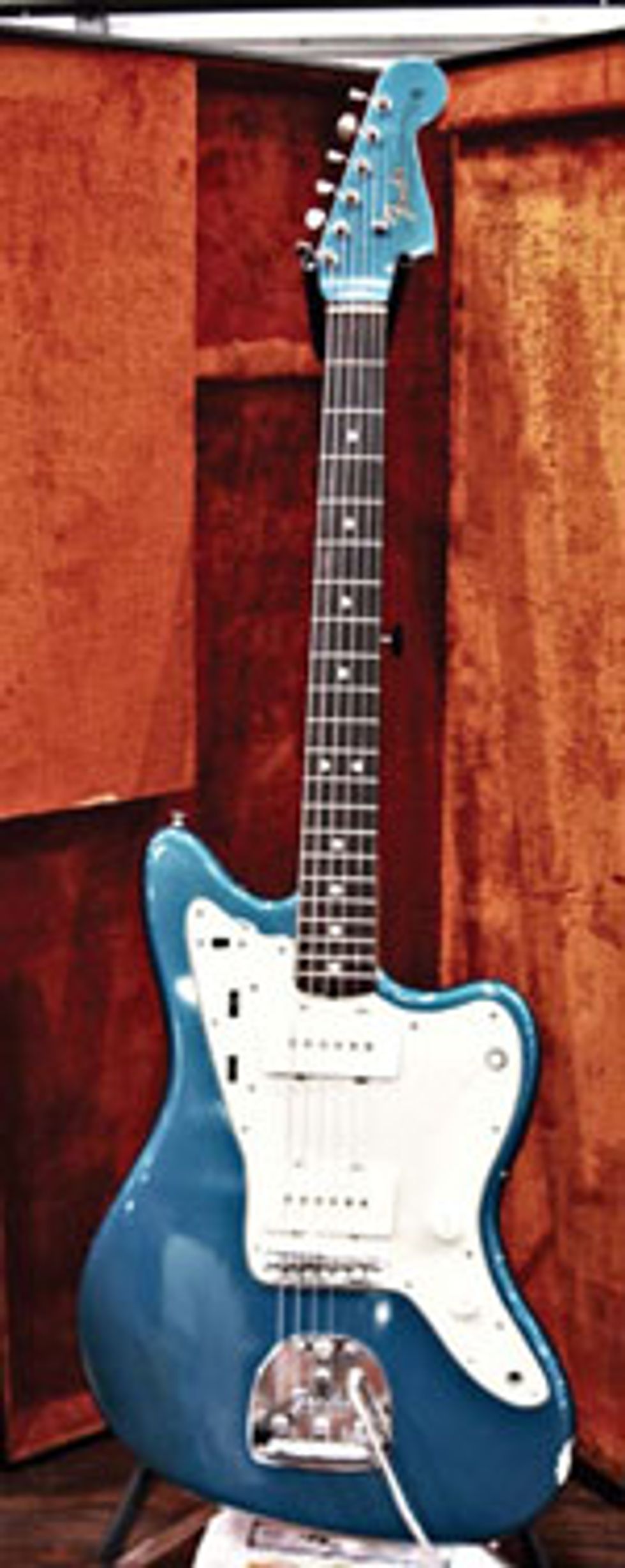 1964 Fender Jazzmaster, $9500 |
Granted, this is fairly rarified territory we’re discussing, examples of golden-era guitars that have spent lifetimes under beds and inside collections. It would be unfair to use adjectives like collapse or implode to describe the vintage market’s last years. “When I think of those words, I think of 1990, when the vintage car market dropped by 90 percent,” says Borden. The truth is that there have been plenty of bright spots in the interim. Flat tops and archtops have remained fairly steady investments, increasing modestly year over year, and sales of guitars up to the $3000 price point have remained healthy through the entire debacle. Likewise, on the extreme top end of the market, owners of original korina Explorers or pristine 1959 bursts are still receiving top dollar for their instruments. But for anything else in between, even tangentially related to modern rock n’ roll—beautiful, vintage electric guitars that were once within reach of musicians but became the province of investors—the downward correction was very real.
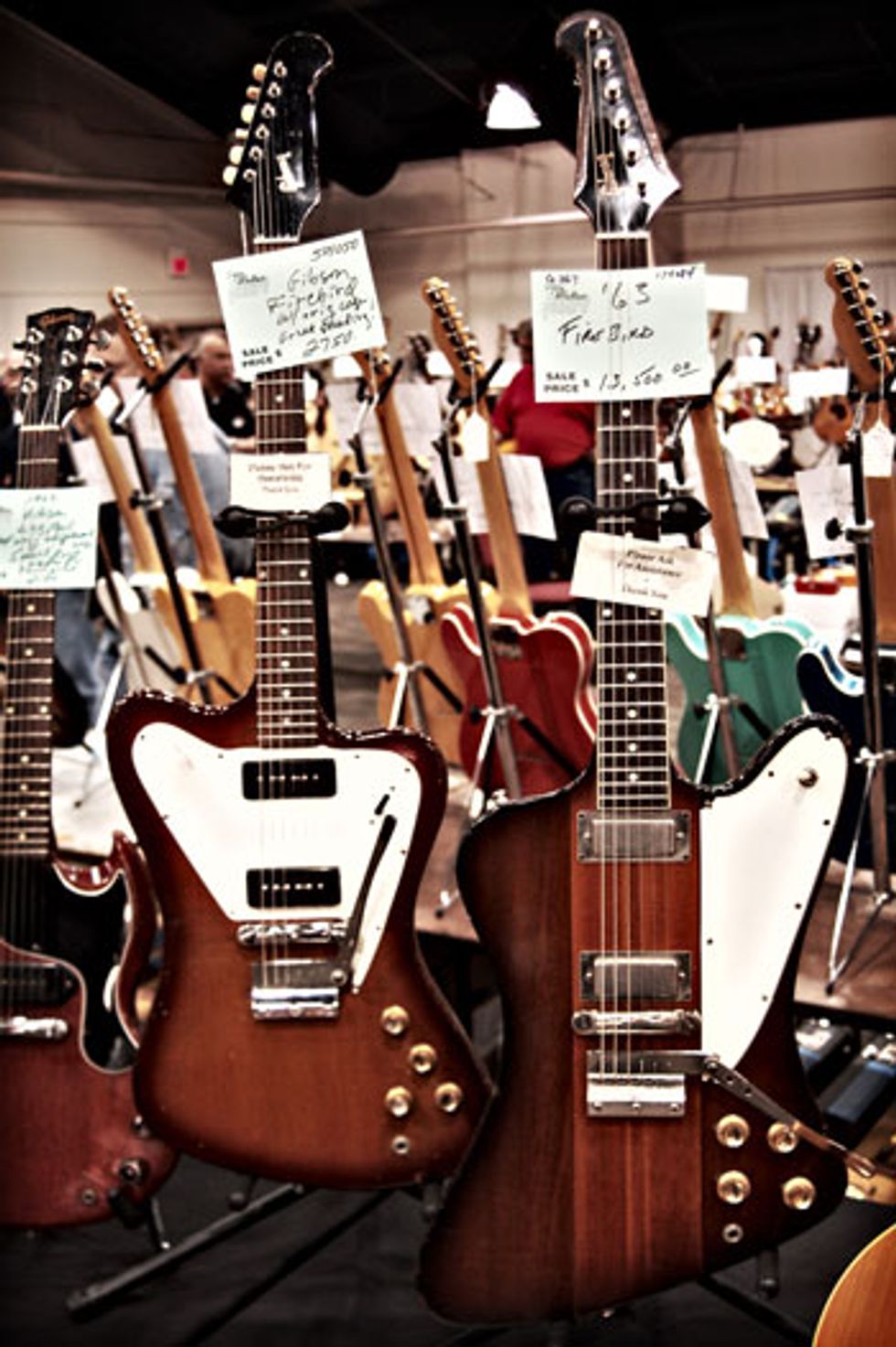 A pair of Gibson Firebirds. |
But if the guitar market finds itself 30 percent down from two years ago, and our own economy has yet to show firm signs of stability, let alone a recovery, what explains the optimism of a professional like Jim Singleton? Perhaps it’s because the market finally seems to be shaking it all out. Dealers have weathered the worst of it, and buyers are slowly but surely returning to the floors and shops, buoyed by several months of decent economic news (or at the very least, not terrible news) and low prices. The recent correction has generally been viewed by dealers as a good thing for the market, allowing some fresh blood to get into the vintage game and lowering the capital outlay required by dealers.
But considering how overheated the market became at its peak, it’s also fair to wonder if that market correction has completely run its course. Even Singleton will tell you he has no crystal ball. Although the signs are beginning to point upwards, no one can really say whether the market has hit its bottom, or if it’s yet to come. There’s no strong consensus on either side, and what you’ll hear from a dealer is highly dependent on how he reads the data. Even among Dave Crocker and John Brinkmann, two people with a vested interest in seeing things go upward and quickly, opinions seemed to differ on the state of the vintage market.“It looks good to me,” Brinkmann says, with very little hesitation. “I’m up.”
Crocker hedges his answer a little bit: “I think it’s still healthy, but we’re making some major, major adjustments. A lot of it is due to the economy, but I think part of it is due to the fact that we saw meteoric, explosive growth that wasn’t healthy for the industry.”
 Dave Rogers |
“The vintage market really peaked about two years ago,” he told me. “It got so crazy and inflated—bursts selling for $400,000; blackguard Teles selling for $60-$70,000—it just had to correct itself. And it is correcting a little bit, but I don’t know if we’ve found the bottom yet. The prices still have yet to really find themselves, and once they do, I think they’ll be a little lower than they are now.”
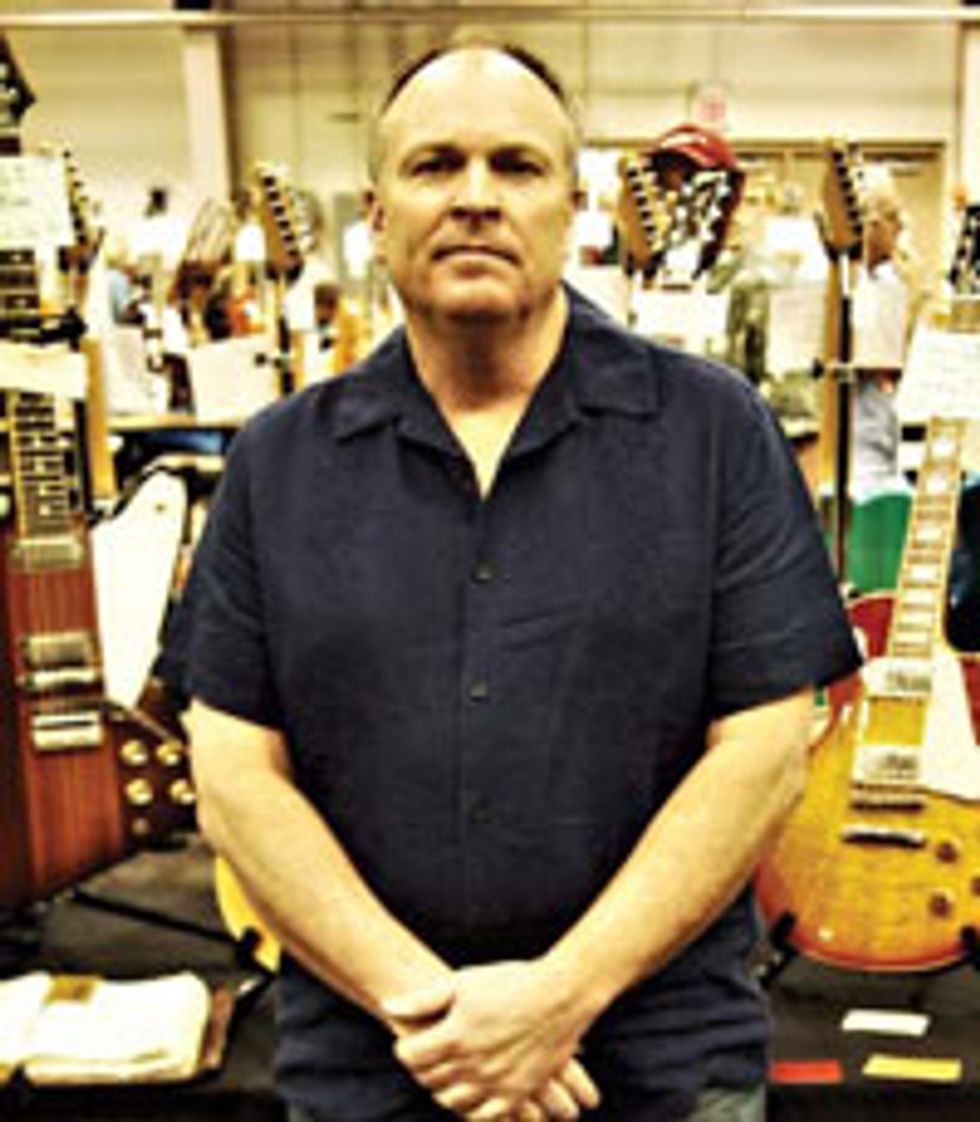 Jimmy Wallace |
That adjustment has taken longer for some dealers than others. Like homeowners realizing their $400,000 mortgage is now only worth $290,000, some dealers are reluctant to realize a huge drop in the value of their assets. It’s resulted in a kind of pricing paralysis by some retailers, and it has manifested itself into a waiting game between buyers and sellers that has muddled signs of a bottom.
“A lot of the dealers are still asking prices that maybe would have sold two years ago, but nobody’s buying today,” says Zachary Fjestad of Blue Book Publications and PG’s “Trash or Treasure” column. “I think a lot of the dealers got pretty far in. They never thought there was going to be a market correction, and they don’t want to reduce their prices because that shows that everything is negotiable again.”
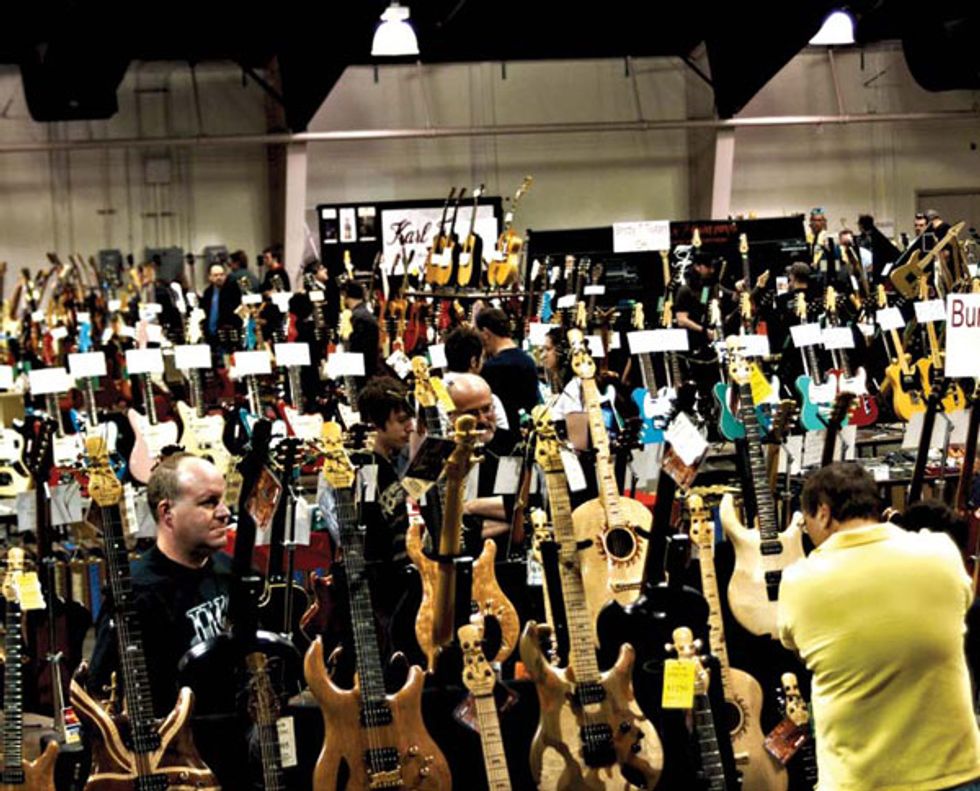 Options abound on the Chicago floor. |
The Future
Of course, the laws of supply and demand, and the dealer mantra of rotating stock, regularly tell us that these reluctant holdouts can’t last long. So, does that mean we’re now looking at an unparalleled buyer’s market in the vintage world? Once again, the answer likely depends on where you sit. If you’re buying vintage guitars as a straight investment (as a money-making proposition), it may be wise to keep an eye on that piece you’ve been waiting for a little longer, until dealers start adjusting prices downward even more to get pieces moving again. “We’ve still got guitars out at prices from a year ago that aren’t selling, so I think we’re going to reduce prices on our vintage stuff to make it happen,” says Rogers. “Everybody is going to do that until they start selling and until we find that happy medium.”
That said, players who have a real love for the instrument but found themselves locked out of the market in the past few years will find this an excellent time to take that step back into the vintage market. Depending on your guitar of choice, bargains abound: good Juniors and SGs are underpriced; Stratocasters and Telecasters are back within reach of players; and refins and repaired guitars are once again viable, affordable options for guitarists needing a “player” they can actually use. “Pricing is down across a lot of sectors of the market, and for the first time in a long time, musicians are buying gear again,” says Kevin Borden.
It’s the fact that musicians are actually returning to market that gives many dealers hope for the future. The passion is returning, and another generation of buyers can now have access to it. “It’s a great time to buy a guitar right now, the best time I’ve seen in 20 years,” says Jim Singleton. “With so many of them on the market, you can pick through them, find the best one and still get a good price.”
“I think it’s great. People are loving it, and we’re having a good time too, because now we can go to a show and buy things at a fair price and sell it at a fair price and everybody walks away happy,” says Rumbleseat’s Eliot Michaels a few days following the Chicago show, when asked about his impressions of the post-correction market. “We used to go to guitar shows with exorbitant amounts of money and walk away with one or two guitars. Now we can go to a show with a small wallet of money and walk away with a lot of guitars, and actually be able to sell them to people. Everybody’s happy.”

